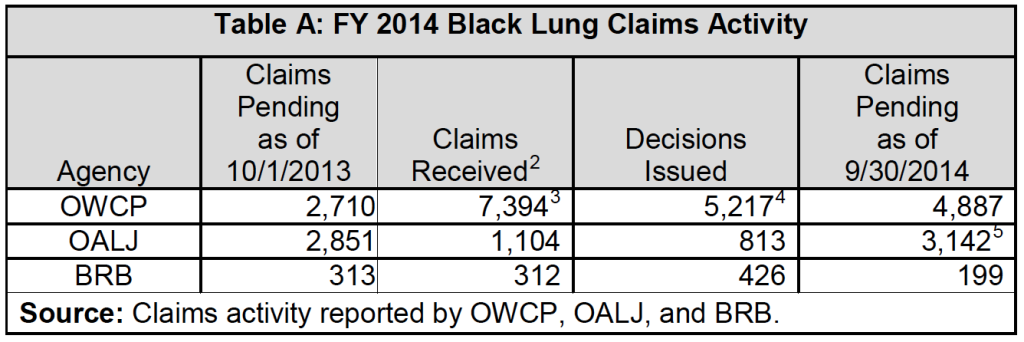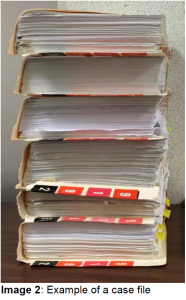Inspector General Criticizes Black Lung Program in Important Audit Concerning Backlog

Example of Black Lung Case File before Administrative Law Judge
Last week the Department of Labor’s Office of Inspector General released a significant—and critical—audit of the federal black lung benefits program’s procedures for deciding claims.
The documented titled “Procedural Changes Could Reduce the Time Required to Adjudicate Federal Black Lung Benefits Claims” provides a detailed look at some of the issues that make the black lung claims system so challenging for coal miners and their families. The report recommends 23 improvements (listed below).
The executive summary described the findings as follows:
We found many opportunities to improve the black lung disease claims process. OWCP could work with its approved medical providers to improve the quality of medical reports and to reduce the time it takes providers to submit those reports. OWCP could also work with the Social Security Administration to expedite access to claimants’ earnings records. OALJ could improve its workload management by establishing performance goals for the disposition of cases for the office as a whole and for its district offices individually. OALJ also needs to address a shortage of staff resources, improve communications between its headquarters and district offices, and upgrade the training provided to judges and law clerks. BRB should consider whether the temporary reassignment of BRB staff to assist OALJ in reducing its case backlog would be a more effective use of resources. DOL should consider streamlining the claims process with an automated system that allows OWCP, OALJ, and BRB to exchange case files. Finally, DOL could take additional actions in response to the recommendations made by the Government Accountability Office in its October 2009 report on the black lung benefits program.
The report contains a wealth of detailed information about the federal black lung benefits program.
Below are a few items that stood out to me:
- A major focus of the report were the delays before the Office of Administrative Law Judges (OALJ). OALJ reported it took an average of 693 days to hold a hearing and issue a decision. Note that this time begins after the Office of Workers’ Compensation Programs (OWCP) makes its initial determination, which the report says averages 235 days, meaning that it takes nearly three years for a miner or widow to receive a decision by a judge. As to the cause of this delay, OALJ reported that from FY2009 to FY2013, its caseload increased by 68%. However, around the same period (from FY2005 to FY2014), it lost 24% of its full-time employees. OALJ reported that it is hiring 31 full-time employees (4 judges, 16 clerks, 2 attorneys, and 9 legal assistants) in addition to replacing outgoing staff. However, even adding 31 FTEs will still leave OALJ 5% below its 2005 staffing levels. Further, 11 of the Inspector General’s 23 recommendations concerned productivity before OALJ, suggesting that there are issues beyond caseload and the number of full-time employees.
- The two OALJ offices that were inspected handled case assignment very differently, resulting in productivity difference among judges that appear to be based on case-assignment methods. Cincinnati gave each of its judges 60 black lung cases per year and new cases were assigned as judges finished cases. Pittsburgh gave each of its judges 100 black lung cases per year regardless of the completion rate. This difference appears to result in different productivity by the judges. The Pittsburgh judges decided 43 cases per full-time employee while the Cincinnati office only decided 26 cases per full-time employee. This meant that although the Cincinnati office has two more employees (8.4 FTEs as opposed to 6.3), it decided 58 fewer cases than Pittsburgh. (Note: In response to the report, the Cincinnati office made a marginal difference its assignment system, assigning 3 more cases to each of its judges, regardless of cases pending before the judge.)
- The need to move away from paper case files was a repeated focus. The report included a photo of a familiar sight to black lung attorneys and representatives: a two-foot high case file with over 7000 pages. OWCP staff said that it could take an entire day just to copy, collate, and ship a single case file to OALJ. OWCP’s new digital records system should help, but because OALJ does not have a digital system to receive files from OWCP, the best current idea is sending a DVD disc from OWCP to OALJ. OALJ says that it is obtaining a system which will become available in FY2016.
- The goal of having a single case-management system that could track cases from OWCP to OALJ and then to the BRB appears far off. “Although each agency has implemented and enhanced its own tracking system, none communicate with one another and there is no system that can routinely track cases through the entire adjudication process.” “OWCP reported to the OIG that integration of the OWCP, OALJ, and BRB systems would take years and many millions of dollars.“
- The report’s discussion of medical reports provided by the Department of Labor was interesting but focused more on the timeliness of reports than the quality. While a prompt report is always preferred, most claimants would prefer that the physician have time to focus on quality. I wish that the Office of Inspector General had included his recommendation from page 26 that “OWCP needs to recruit physicians who are capable of drawing arterial blood gas samples continuously during exercise” as one of his numbered recommendations in the conclusion to draw more attention to the important of using indwelling catheters for exercise testing of miners. As to the importance of quality, the following paragraph succinctly describes a major problem for many miners seeking benefits:
During our review of case files, we noted significant differences in the level of detail and comprehensiveness of documentation among medical reports. OWCP field office personnel told OIG that OWCP’s medical providers’ reports were generally less detailed than the medical reports presented by mine operator-paid physicians at all levels of the claims review and adjudication process. At times, OWCP claims examiners had to follow up with physicians to obtain more information and additional clarity, which contributed to overall delays in the claims process. Claims examiners and ALJs are required to base their decisions on well-reasoned medical reports. Differences in the level of detail in OWCP’s, claimants’, and mine operators’ medical reports could impact claim outcomes.
- The report also included a snapshot of pending claims before OWCP, OALJ, and BRB at the end of FY2014. As the table below shows, during FY2014 the backlog increased at the first two steps of the black lung claims process (OWCP and OALJ). The Board has made progress and essentially has no backlog. (The report noted that the Board averages 328 days to issue a decision, meaning that most claims are decided within a year.)

This audit is another result of the Pulitzer Prize-winning Breathless and Burdened series done by investigative journalists at the Center for Public Integrity. The series raised questions that the U.S. House of Representative’s Committee on Education and the Workforce asked the Inspector General’s office to review. For the Center for Public Integrity’s response to the audit, see their story “Much Room for Improvement in Flawed Black Lung Benefits Program, Audit Finds.”
Information from this report will likely make its way into future posts, but that’s my first impression of this impressive and important audit from the Department of Labor’s Office of Inspector General.
——
Recommendations
We recommend the OWCP Director:
1. Continue to enhance and periodically evaluate the effectiveness of incentives to medical providers for turning in completed medical reports within certain timelines.
2. Explore the feasibility of seeking legislative authority for online access to SSA earnings records, and in the interim, attempt to renegotiate with SSA to allow OWCP to submit requests for earnings verification to SSA electronically.
3. Develop a program to periodically screen whether medical providers are properly licensed and in good standing in their state of practice and remove medical providers from the list in appropriate situations.
4. Present OWCP claim statistics that show the number of claims approved, the number denied, the number abandoned, and the number withdrawn.
5. Coordinate with BRB and OALJ to evaluate the feasibility and costs of transmitting OWCP’s already digital case files via electronic means instead of hard copy.
6. Evaluate the results of OWCP’s pilot program aimed at strengthening the pulmonary evaluation upon its conclusion and decide which actions should be permanently included as part of the claims process.
7. Conduct comprehensive analyses of the benefits and costs of pursuing statutory changes to BLBA to introduce:
a. referee medical examinations;
b. methods for increasing claimant legal representation;
c. compensation for partial disability; and
d. settlement of claims.
We recommend OALJ’s Acting Chief Administrative Law Judge:
8. Seek resources to replace outgoing judges and law clerks.
9. Add optional extensions to the term of law clerks and stagger the hiring of law clerks.
10. Reinstate the contract writer program.
11. Implement additional formalized training programs for incoming law clerks and judges.
12. Establish and promulgate centralized, written policies, procedures, or templates to improve efficiency and communication among the districts.
13. Implement a distance hearing program, which could include video or telephone hearings, to reduce judges’ travel costs and time.
14. Coordinate with OWCP and BRB to evaluate the feasibility and costs of an electronic case management, tracking, and storage system that could exchange case file information electronically with OWCP and BRB.
15. Establish timelines and performance goals for the disposition of cases for OALJ as a whole and for its district offices individually.
16. Consider transitioning the Cincinnati OALJ office to the case assignment methodology currently used by the Pittsburgh OALJ office.
17. Implement a time tracking system for judges and law clerks to record the amount of time spent on each case.
18. Coordinate with BRB to prepare and implement a plan for detailing all staff not directly required for the BRB’s own adjudicatory processes.
19. Implement recommendation #1 from GAO’s 2009 report and develop a system of regular communication with BRB leadership to better coordinate activities in which both have common interests.
We recommend BRB’s Acting Chair and Chief Administrative Appeals Judge:
20. Recall detailees from other agencies and coordinate with OALJ to prepare and implement a plan for detailing to OALJ all staff not directly required for BRB’s own adjudicatory processes.
21. Develop a plan for preventing detailees returning from OALJ from working on cases they worked on at OALJ.
22. Develop a system of regular communication with OALJ leadership to better coordinate activities in which BRB and OALJ have common interests.
23. Coordinate with OWCP and OALJ to evaluate the feasibility and costs of an electronic case management, tracking, and storage system that could exchange case file information electronically with OWCP and OALJ.
